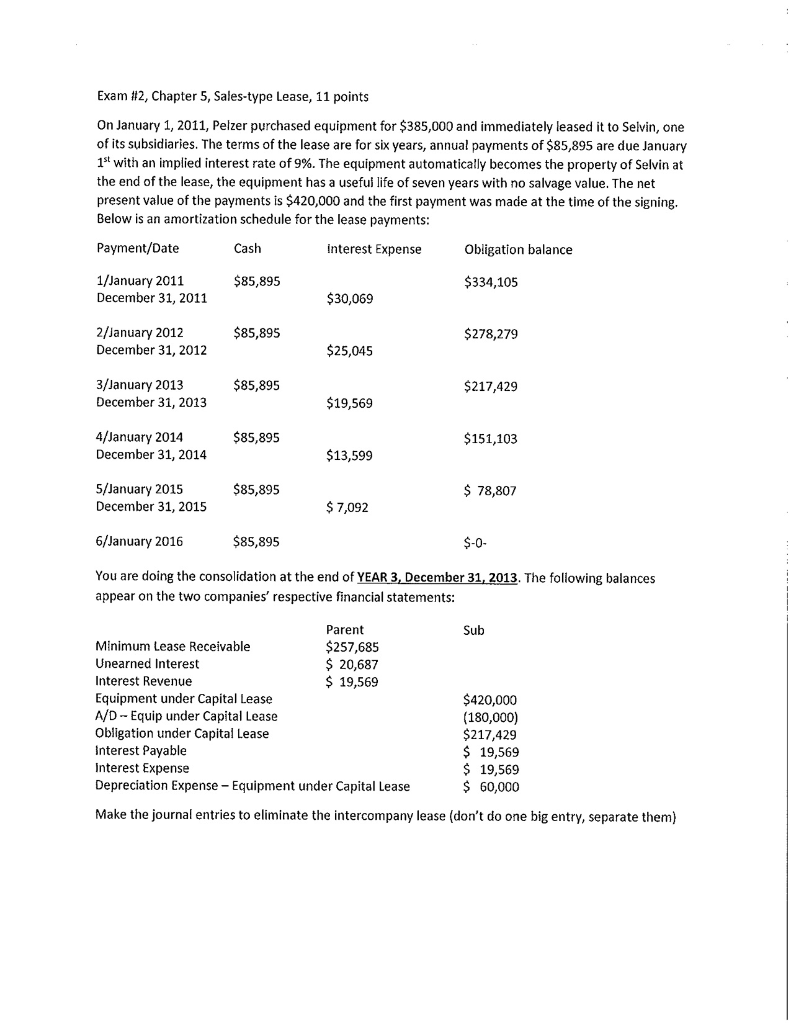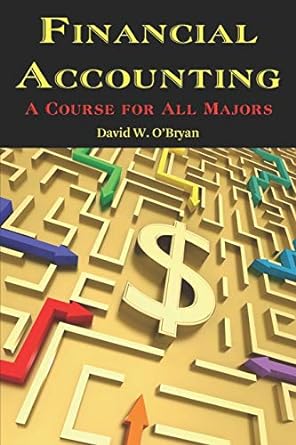Answered step by step
Verified Expert Solution
Question
1 Approved Answer
Required: Make the elimination entries to eliminate the intracompany lease. Exam #2, Chapter 5, Sales-type Lease, 11 points On January 1, 2011, Pelzer purchased equipment
 Required:
Required:
Make the elimination entries to eliminate the intracompany lease.
Exam #2, Chapter 5, Sales-type Lease, 11 points On January 1, 2011, Pelzer purchased equipment for $385,000 and immediately leased it to Selvin, one of its subsidiaries. The terms of the lease are for six years, annual payments of $85,895 are due January 1st with an implied interest rate of 9%. The equipment automatically becomes the property of Selvin at the end of the lease, the equipment has a useful life of seven years with no salvage value. The net present value of the payments is $420,000 and the first payment was made at the time of the signing. Below is an amortization schedule for the lease payments: Payment/Date Cash interest Expense Obligation balance $85,895 $334,105 1/January 2011 December 31, 2011 $30,069 $85,895 2/January 2012 December 31, 2012 $278,279 $25,045 $85,895 $217,429 3/January 2013 December 31, 2013 $19,569 $85,895 $151,103 4/January 2014 December 31, 2014 $13,599 $85,895 5/January 2015 December 31, 2015 $ 78,807 $ 7,092 6/January 2016 $85,895 $-0- You are doing the consolidation at the end of YEAR 3, December 31, 2013. The following balances appear on the two companies' respective financial statements: Sub Parent Minimum Lease Receivable $257,685 Unearned Interest $ 20,687 Interest Revenue $ 19,569 Equipment under Capital Lease A/D -- Equip under Capital Lease Obligation under Capital Lease Interest Payable Interest Expense Depreciation Expense - Equipment under Capital Lease $420,000 (180,000) $217,429 $ 19,569 $ 19,569 $ 60,000 Make the journal entries to eliminate the intercompany lease (don't do one big entry, separate them) Exam #2, Chapter 5, Sales-type Lease, 11 points On January 1, 2011, Pelzer purchased equipment for $385,000 and immediately leased it to Selvin, one of its subsidiaries. The terms of the lease are for six years, annual payments of $85,895 are due January 1st with an implied interest rate of 9%. The equipment automatically becomes the property of Selvin at the end of the lease, the equipment has a useful life of seven years with no salvage value. The net present value of the payments is $420,000 and the first payment was made at the time of the signing. Below is an amortization schedule for the lease payments: Payment/Date Cash interest Expense Obligation balance $85,895 $334,105 1/January 2011 December 31, 2011 $30,069 $85,895 2/January 2012 December 31, 2012 $278,279 $25,045 $85,895 $217,429 3/January 2013 December 31, 2013 $19,569 $85,895 $151,103 4/January 2014 December 31, 2014 $13,599 $85,895 5/January 2015 December 31, 2015 $ 78,807 $ 7,092 6/January 2016 $85,895 $-0- You are doing the consolidation at the end of YEAR 3, December 31, 2013. The following balances appear on the two companies' respective financial statements: Sub Parent Minimum Lease Receivable $257,685 Unearned Interest $ 20,687 Interest Revenue $ 19,569 Equipment under Capital Lease A/D -- Equip under Capital Lease Obligation under Capital Lease Interest Payable Interest Expense Depreciation Expense - Equipment under Capital Lease $420,000 (180,000) $217,429 $ 19,569 $ 19,569 $ 60,000 Make the journal entries to eliminate the intercompany lease (don't do one big entry, separate them)Step by Step Solution
There are 3 Steps involved in it
Step: 1

Get Instant Access to Expert-Tailored Solutions
See step-by-step solutions with expert insights and AI powered tools for academic success
Step: 2

Step: 3

Ace Your Homework with AI
Get the answers you need in no time with our AI-driven, step-by-step assistance
Get Started


